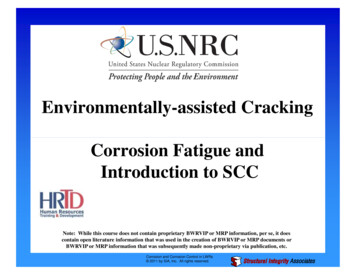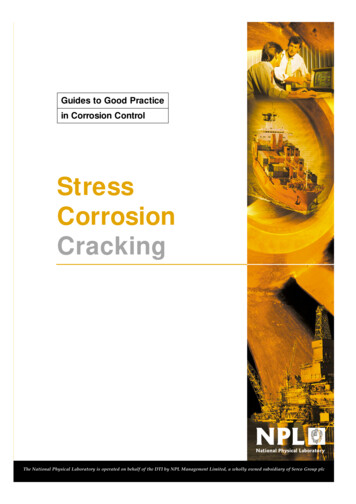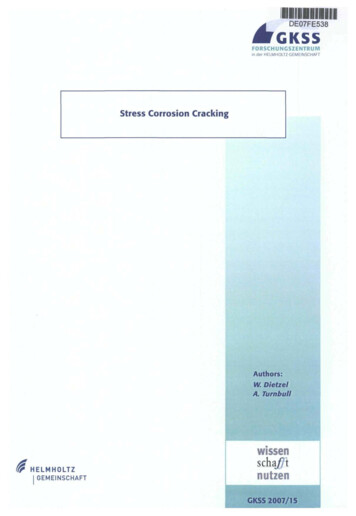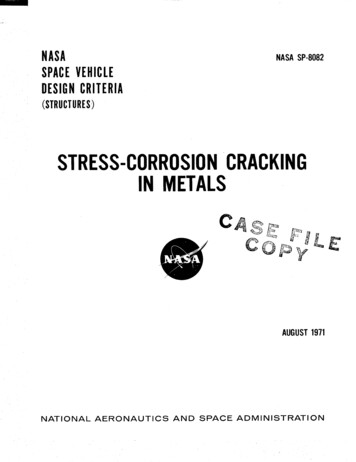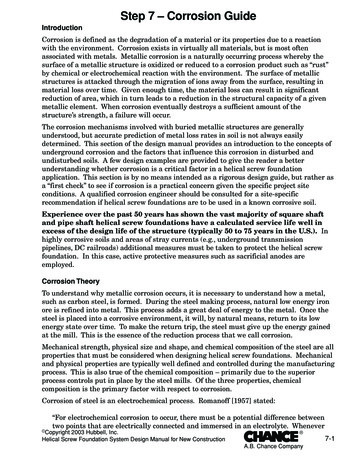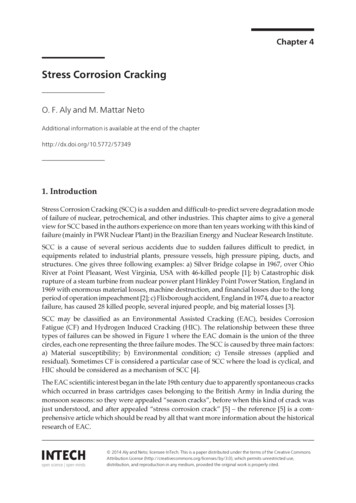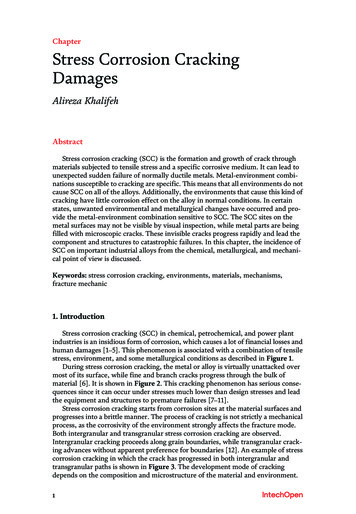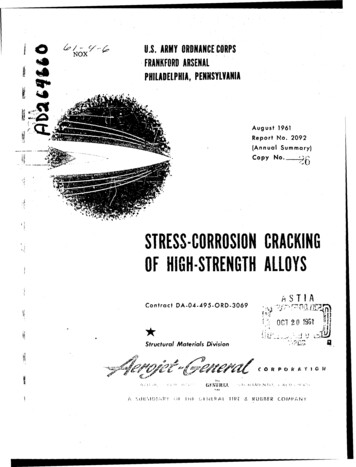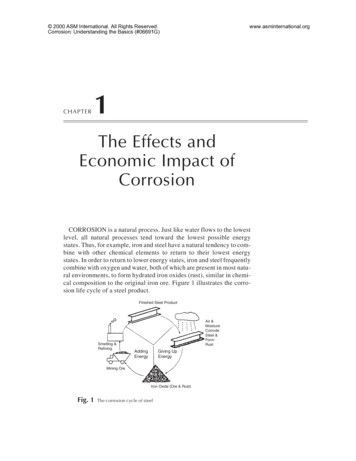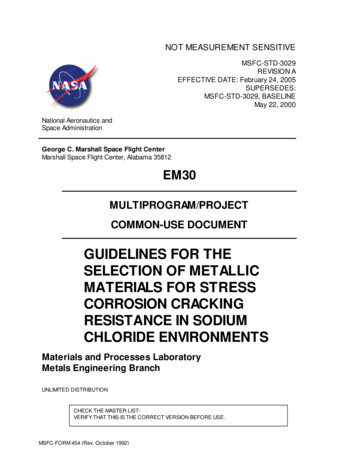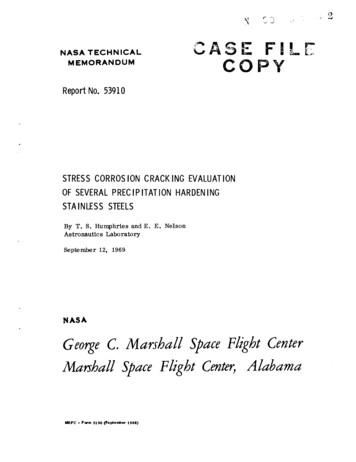
Transcription
0NASACASEF! LFCOPYTECHNICALMEMORANDUMReport No. 53910STRESS CORROSION CRACKING EVALUATIONOF SEVERAL PRECIPITATION HARDENINGSTA INLESS STEELSByT.S. HumphriesAstronauticsand E.E.NelsonLaboratorySeptember12,1969NASAGeorge C. MarshallMarshallMSFC*Fm,m3190Space Flight3es embet1968)SpaceFlight CenterCenter, Alabama
TECHNICAL1.REPORTNO.NASA4.I ation9.StainlessS.PERFORMING8. GANIZATIONFlightAGENCYFlightCea er,NAMEANDNG ORGANIZATIONWORKUNITCONTRACTOR 362,(roundPH13-8Mo,stainlessinpractically: d 17-7KE'YPH212PH14-8Mo,steelsallareC -4PH,resistanttreatstress15-7areandA-286,toPH212to alternateimmersionindicatedthat under15-5susceptibleconditionsSCT 850 butresistance14-8tensile,areil at treat(i iditionPHAM-350,employedand weresubjectedsaltsolution.The ings)Threewerein a ing900, and AM-350isto MENTSTARAnnouncement19.SECURITYCLASSIF.(ofUMSFC- DRECIPIENT'SSECURITYCLASSIF.U(of thispillle)121.NO.OF2tPAGES22.PRICECOVERED#
TABLEOFCONTENTSPageSUMMARY . .INTRODUCTIONPROCEDUREANDCONCLUSIONSREFERENCES. . -o .EXPERIMENTALRESULTS . . DISCUSSIONAND11.2.3RECOMMENDATION.iii45
LIST OFTABLESTableIIIIIIIVTitlePageChemical Composition of Precipitation HardeningStainless Steel .6Mechanical Properties of Precipitation HardeningStainless Steel .7Heat Treatments .9Stress Corrosion Cracking Test Results .iiLIST OF ILLUSTRATIONSFigureTitlePage1Flat Tensile SpecimenStressed in Direct Tension.172RoundTensile and "C"-Ring Type Stress Corrosion TestSpecimen.18Flat Tensile SpecimensLoaded in a Constant SpanFixture .19Alternate20Immersion Tester .iv
itempcorrosionconditions17-7PH-CH900,CH 900conditionSCTon(alternateofa oreindicatedA-286,heatsteelsexceptin n15-5waterPHin ackingMois vehicles.thechromium- nickel reelsofthe lessof the sicallyheatagingoftwotypes:
The PH stainless steels like the hardenable chromium stainlesssteels may under certain conditions of tensile stress and corrosiveenvironment suffer stress corrosion.As with most metals, the stresscorrosion cracking susceptibilitynormally increases with increasinghardness or strength.However, susceptibilityis not governed solelyby hardness or strength of the material, but in certain cases appearsto be associated with the process procedure used to obtain these properties.For example, both 17-7 PH and PH 15-7 Mo stainless steelsexhibit the highest resistance to stress corrosion cracking in ConditionCH 900 although this condition gives the highest hardness of any of theavailable heat treat conditions of these two alloys (2).EXPERIMENTALPROCEDURESThe PH stainless steels evaluated in this investigation werePH 13-8 Mo, PH 14-8 Mo, 15-5 PH, PH 15-7 Mo, 17-4 PH, 17-7 PH, A-286,Almar 362, AM-350, and Unitemp 212 in the form of bar stock and/orsheet. Three types of specimens were required to test the material inat least two directions of grain orientation.Flat tensile specimens,loaded by constant deflection, were used for testing sheet material;round tensile specimens, stressed in direct tension, were used fortesting the longitudinal direction of all bar stock and the transversedirection of two inch or greater diameter bar; and C-rings, utilizingthe constant deflection method, were used for testing the transversedirection of bar stock of less than two inch diameter. In one case,(17-4 PH Condition A) flat tensile specimens were stressed in directtension, and this is illustratedalong with the other methods of loadingin Figures I, 2, and 3.The specimens were deflected or strained the calculated amount togive the desired stress levels, wiped with acetone, and placed in thealternate immersion tester until failure or until the test was terminated (approximately six months). A detailed description of the testspecimens, formulas for calculating deflection and strain, and methodsof loading and testing is given in Reference 3. Mechanical propertiesof the alloys were measuredin both directions of testing.The chosenstress level was from 25 to I00 percent of the directional yieldstrength except as noted for small diameter bar. Duplicate unstressedtensile specimens were exposed under identical conditions for comparativecontrol.The tests were conducted in a ferris wheel type alternateimmersion tester (Figure 4) containing a 3.5 percent solution (deionizedwater) of sodium chloride, with an immersion cycle of I0 minutes insolution followed by 50 minutes of drying above the solution.2
RESULTSANDDISCUSSIONThe compositions of the alloys evaluated in this program arelisted in Table I. In somecases, the typical analysis is given becausethe composition of the specific material was not available.Themechanical properties and the heat treatments used to obtain the properties of the PH stainless steels are shown in Tables II and III,respectively.Listed in Table IV are the complete stress corrosionresults obtained in this investigation.Armco's* martensitic PH stainless steels (PH 13-8 Mo, 15-5 PH,and 17-4 PH) were found to possess a higher degree of stress corrosionresistance than their semi-austenitic type (PH 15-7 Mo, and 17-7 PH).No failures were encountered in the three martensitic stainless steelsin most forms and heat treat conditions tested at loads up to i00percent of their yield strengths. The only stress corrosion failureoccurred in 17-4 PH-H 900 bar stock stressed in the transverse graindirection to I00 percent of the yield strength.This agrees withinformation published by Armco(2), which states that, for maximumresistance to stress corrosion cracking, 17-4 PH should be hardenedat the highest temperature that will yield required properties, but notless that IO00 F. However, the results obtained with Condition-Amaterial does not agree with Armco's information-thatthe structure of17-4 PH Condition A is untemperedmartensite having poor resistance tostress corrosion cracking. No stress corrosion failures were encounteredwith either sheet or bar stock of 17-4 PH Condition A at stress loadsup to I00 percent yield strength exposed to both alternate immersionin salt water and salt spray.The semi-austenitic type PH 15-7 Mo and 17-7 PH suffered stresscorrosion cracking in all conditions of heat treat except the CH 900.The only condition in which 17-7 PH steel was found to possess a highresistance to stress corrosion cracking was the cold rolled and hardenedCH900. Both PH 14-8 Mo and PH 15-7 Mo are, reportedly, resistant tostress corrosion cracking in Condition CH900 1,2). This is somewhatsurprising because the highest mechanical properties obtainable fromthese three semi-austenitic stainless steels are produced by ConditionCH900. The test results indicated that the transverse grain directionof both sheet and bar of PH 15-7 Mo and 17-7 PH was more susceptibleto stress corrosion cracking than the longitudinal direction.Inaddition, both alloys were more susceptible to stress corrosion crackingwhen hardened at 950 F than II00 F (lower mechanical properties).Itwas reported that PH 15-7 Mo is more resistant to stress corrosion than17-7 PH and the TH condition is more resistant than the RH(1). The*Armco Steel Corporation
resultsof this investigationa stresscorrosionstandpoint,did not substantiatethe semi-austeniticthese findings.PH 14-8 Mo wasFromsimilarto the martensiticstainlesssteelsin that this alloy was highlyresistant to stresscorrosioncrackingin all heat treat conditionstested.Of the ed,A-286,Almar 362, and Unitemp212 were highlyresistantto stresscorrosioncrackingin all test tempersor conditions.Alloy AM-350wasfoundto be resistantto stresscorrosioncrackingin the SCT I000conditionbut susceptiblein the higherstrengthSCT 850 condition.Aswith alloysPH 15-7 Mo and 17-7 PH, alloy AM-350was more susceptibletostresscorrosioncrackingin the transversegrain directionthan in thelongitudinaldirection.CONCLUSIONSTheI.17-4 isacceleratedtestThe precipitationhardeningPH 13-8 Mo, PHA-286,Almar 362, and Unitemp212 stainlessto stresscorrosioncracking.indicatedthat:14-8 Mo, 15-5 PH,steelsare highly2.AlloysPH 15-7 Mo and 17-7 PH were susceptibleto stresscorrosion crackingin all heat treat conditionstestedexceptCH 900, andAM-350was resistantin ConditionSCT I000 but susceptiblein ConditionSCT esistantto stresscorrosioncrackingin the transversegrainorientationthan in the longitudinaldirection.to be lessdirectionof4.The stresscorrosioncrackingsusceptibilityof the easedwith increasinghardnessor strength,but in certaincases appearsto be associatedwiththe processprocedureused to obtainstainlesssteel exhibitedthe highestcrackingin ConditionCH 900 and thisand strengthof any of the ardeningstainlessheat treat ntested.resistancetheandto stressthese properties.Alloy17-7 PHresistanceto stresscorrosiongaveshouldthehighestbe determinedhardnessforsteelsin all recommendedprocessthe effectof these conditionsoncracking.
Steel ctural1967.PH),15-7 osionStressData(17 -7 n1966.Mo),
o oo ozlo oooooo oo. o oooooooooooooooooooooooo. 2 . 22
0oZZZoE0 H0E.- ;-.1 [-0:--10 o0 0. . 000 0it 0o000ocOI0,-4,-r-"0,---to,I'o, ,"00uo010
Q; .o0vCOr.ECOoZor-iCOZZ.H;]-,00 0 0IwO O000 100 -,0O00 O,---ioN.,.4OE-
TABLEI.PH13-815-5H900- 90OF,H925,H950,PH2.Mo,14-8MoAustenite- SRHa 15-7b ingattemperaturefor4 hours10501700F,cooling:1 hour,IOOF,A.C.8 hoursindicatedtemperatureforI eing1725,I0min.MinusIOOF,specificationper0. I ling:Precipitationhardening:8 hoursI 0 minutesplusMA0111-009)I minuteforA.C.MinusIOOF,I075F,4 hoursI hourPHConditionHeatedatCH 900 (materialcold900F for one ionC,950HEATA.C.- dI hour,HI025Transformation3 PH,III.atTHreducedRHtoConditionC)Ii00i0 minutes,IOOF,A.C.8 thin1 oureach
TABLEIII.HEATTREATMENTS*(Continued)5. A-286a. A-286Solution treated 180OF,2 hours, W.Q., aged1325F,16 62Aged1000F,350LTAUnitempa.b.* Allf02 i000A.C.,minusIOOF,3 hours,temperatindicated3 hours.212Doubleaged1250F,16 hoursSingleagedmaterialtreated1800F,hours,5 minutes,temperature8.163 hours- SCT171OF,worktreated1200F,AlmarAMcoldby- Solution- tedbysolutionnoted.2 162 hours,hours,conditionbyandA.C.,MSFCheat
6Annealed)Trans.110148Long.110148Trans.110148Ba 075I00(2)0/! (2)0/3(3)0/3(3)0/5(3)0/3(3 00--156750/3207100(4)0/9(4)0206Trans.I000/3ii
925RESULTS(I)0Dia.)HTESTI00N
N800--56252/3I 1750/3205900/311450O/3171750/3205900/313
,165(3)NN,423N13,29N1124
TS(Stress% rock(I.75"AgedDia.)3IO00 00/3120750/3I000/3(5) 750/3188i002/25.20140752/320,153187I002/2I(2)--15
ZZZoo.do!iei!,-.-i0rOvCoO0OOOO0O0oo00000-,' 110o. oo0o o" 1.Zor-ou'h ',,,. ,-Z iv:,.r"0o.M .o 1.io I.',oo., oJo:ooJ ,,,4.0OE-Z16oZ:0
zo(/)zwffUw0::::oZow(j)(/)w0::::f(/)Zw Uwa.(/)w.J(/)Zwff-oe:(.Jl.L.17
i-'-00FIGURE 2 - ROUND TENSILE AND C-RING TYPE STRESS CORROSION TEST SPECIMENS
W0:::::J Xl.L.Z«a.(/) z« (/)zuo«zowo«o---l(/)Zw Uwa.Cf)w---l(/)Zw «---ll.L.(Y)W0:::::J .9l.L.19IJ
l0::Wl-e/)WIZoe/)0::W 20
INGTM X-53910EVALUATIONSTAINLESSOF SEVERALSTEELSByT.S. HumphriesandE.E.NelsonThe informationin this reporthas been reviewedfor securityclassification.Reviewof any informationconcerningDepartmentofDefenseor AtomicEnergyCommissionprogramshas been made by theMSFC SecurityClassificationOfficer.This report,in its entirety,has been determinedto be rovedfortechnicalaccuracy.E.C. McKannanChief,MetallicM/rials':BrafR. J. Schwingha'mer. Chief,MaterialsDivisionKarl L. a21
DISTRIBUTIONS&E -ASTN -DIRS&E-ASTN-DIRS &E -A STN -MS&E -ASTN -MMS&E -ASTN -PS&E -ASTN -ES&E -ASTN -EMS&E -ASTN -EAS&E -ASTN -ESS&E -A STN -AS&E -ASTN -TS&E -ME -DIRS&E ME MMS&E -ME r.Mr.EnglerSterettGraftonSiebelWilsonMr. AngeleMr. GrauS&E -QUAL-DIRS&E -DIRMr. WeidnerPD-DIRDr. LucasS&E-CSE-DIRDr. HaussermannS&E-ASTR-DIRMr. MooreA&TS -MS-HMr. AkensA&TS -MS - IPMr. ZiakA&TS -TUJean Bond (6)A&TS -MS -ILMiss Robertson(8)S&E -ASTN -RMMiss ScottS&E -ASTN -MMCMr. Humphries(25)Scientificand TechnicalInformationFacility(25)Attention:NASA Representative(S-AK/RKT)College22 Park,Maryland
resistance to stress corrosion cracking was the cold rolled and hardened CH900. Both PH14-8Moand PH15-7Moare, reportedly, resistant to stress corrosion cracking in Condition CH900 _1,2). This is somewhat surprising because the highest mechanical properties obtainable from these three semi-austenitic stainless steels are produced by Condition CH900.
